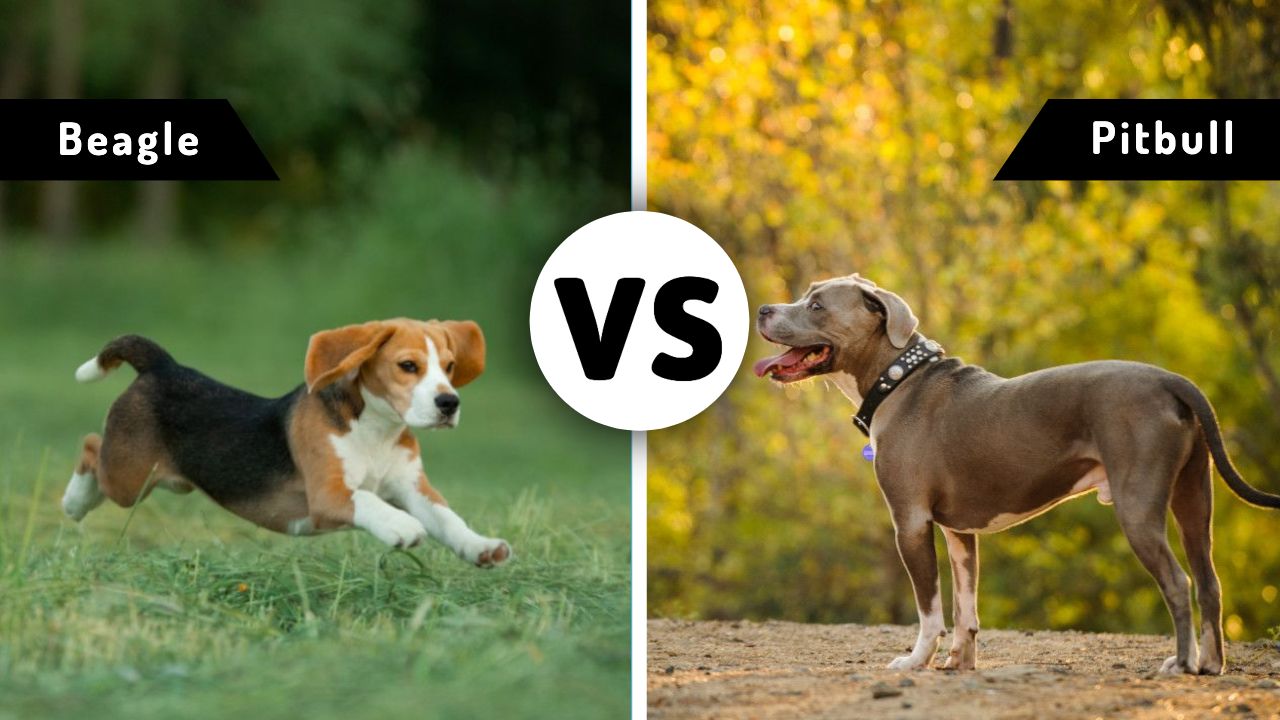
Are you stuck deciding if you should get a Beagle or a Pitbull and seeking a comparison between these two breeds? If so, you’ve come to the right place!
We will go over the similarities and differences between the Beagle and the American Pit Bull Terrier, covering everything from their history, physical characteristics, and temperament to their exercise and grooming needs to help you determine which breed is the better fit for you.
So, without further ado, let’s jump right in and find out!
| BREED COMPARISON | ||
|---|---|---|
| Beagle | American Pit Bull Terrier | |
| Weight | 18 - 35 pounds | 30 to 60 pounds |
| Height |
Come in two varieties: 13 inches & under 13 - 15 inches |
17 to 21 inches |
| Size | Small- to medium-sized dogs | Medium-sized dogs |
| Temperament | Curious, Friendly, Cheerful | Friendly, Loyal, Confident |
| Trainability | 3.0 out of 5.0 stars3.0 | 4.0 out of 5.0 stars4.0 |
| Energy Level | 4.0 out of 5.0 stars4.0 | 4.0 out of 5.0 stars4.0 |
| Life Expectancy | 10-15 years | 10-12 years |
| Shedding | Moderate | Low |
| Hypoallergenic | No | No |
| Puppy Costs | $1500 to $2,500 | $1,000 to $5,000 |
| Takeaways | Beagles are curious, active dogs who love to explore the world around them. They are ideal for people who want an energetic and friendly companion to take on hikes, walks, and other outdoor activities. Known to be led by their noses, Beagles are determined little dogs who can be challenging to train, and therefore, they perhaps aren't the best breed for first-time dog owners. | American Pit Bull Terriers (APBTs) are muscular, athletic dogs full of energy. Unfortunately, they are often misunderstood and considered dangerous because of their past association with dog fighting. In reality, they are loving, loyal, and affectionate dogs who make great companions. They are also intelligent and eager to please, making them relatively easy to train. |
Breed History & Origin
The Beagle is one of the longest-standing breeds, with a history that mentions hounds similar to them as early as the 5th century BC in Greece. However, the Beagle as we know them today didn’t really start to take shape until the 1700s, when various breeds, including the North Country Beagle, Southern Hound, and Foxhound, were crossbred to create a perfect hare and rabbit hunting dog. Today, Beagles are still used for hunting in many parts of the world and are also one of the most popular family pets.
On the other hand, the American Pit Bull Terrier (APBT) has a much more recent history, with its origin dating back to the 19th century in England. They were bred for bloodsports, where these dogs were pitted against other animals for entertainment. And unfortunately, Pitbulls still suffer from negative public perception today, often unfairly stereotyped as aggressive and dangerous dogs due to their fighting past.
Appearance
It’s very easy to tell a Beagle and a Pitbull apart, as they are two very different-looking dogs.
Beagles are small to medium-sized dogs with a compact build and come in two varieties: those with a standard height of 13-15 inches and those under 13 inches. They have a smooth, dense coat available in many different colors and patterns, with the most common and popular being tricolor (black, tan, and white). They also have floppy ears and a tail that is carried high, slightly curved, and usually white-tipped.
On the other hand, Pitbulls are much larger dogs with a muscular and stockier build. They typically stand between 17-21 inches tall and weigh anywhere from 30-60 pounds. They have a short, stiff coat that, too, can be found in various colors, including black, white, fawn, brown, red, and gray. Their ears can be either cropped or natural, and their tail is thick at the base and tapers to a point.
Temperament
When it comes to temperament, Beagles and Pitbulls couldn’t be more different.
Beagles are known for being friendly, outgoing, and lively dogs that love to play and have a lot of energy. Also, they are very curious and have a strong sense of smell, which often gets them into trouble! In fact, Beagles are notorious escape artists and have been known to run off if they catch a scent of something interesting.
Also, because Beagles were bred for hunting, they have a strong prey drive and may not be suitable for homes with small animals like rabbits or rodents. And though they are good with children, their high energy level and strong hunting instinct can sometimes make them a bit too much for very young kids to handle.
As for Pitbulls, they are often misunderstood as being aggressive and dangerous dogs. However, this couldn’t be further from the truth! While it’s true that they were originally bred for fighting, this does not mean that all Pitbulls are naturally aggressive. In fact, when properly trained and socialized from a young age, they can be some of the most loving and gentle dogs around. Also, they are incredibly loyal and protective of their families and will do anything to keep their loved ones safe.
Exercise Needs
Both Beagles and Pitbulls are active dogs, though the Beagle is slightly more energetic, and both breeds will need a good amount of daily exercise to stay happy and healthy. Otherwise, they may become restless and destructive.
The Beagle needs at least an hour of exercise every day. A good walk or run around the block twice a day is usually enough to tire out most Beagles. They also enjoy playing fetch, hide-and-seek, and treasure hunt, and make sure that you include plenty of brain games and puzzle toys to keep their minds stimulated.
Pitbulls have about the same exercise needs as Beagles, requiring at least an hour of daily physical activity. A moderate walk or jog should be enough to get their heart pumping, and they love playing fetch, tug-of-war, and swimming. Like Beagles, Pitbulls also need mental stimulation and will benefit from puzzle toys and interactive games.
Training
Beagles’ strong hunting instinct and prey drive can make training them challenging because they may be more interested in following their nose than listening to you, especially if there are interesting smells around! In fact, Beagles have been known to be quite stubborn and hardheaded at times. And as such, they may not be the best fit for first-time dog owners. That doesn’t mean they can’t be trained, though. It will just take a little patience and consistency on your part. And as long as you are firm yet fair with your training, they’ll eventually catch on.
On the other hand, Pitbulls are intelligent and eager to please their owners, making them relatively easy to train. One thing, though, early socialization is crucial for Pitbulls due to the stigma surrounding this breed. So be sure to expose them to as many different people, places, and experiences as possible when they are still puppies to help them grow into confident, well-rounded dogs.
You May Also Like: How to Stop Your Dog From Destroying Things
Health
Both the Beagle and the Pitbull are relatively healthy breeds. Beagles typically live between 10 and 15 years, while Pitbulls have a lifespan of around 10 to 12 years. And like all dogs, they are susceptible to certain health conditions.
Some common health issues that Beagles suffer from include cherry eye, dwarfism, epilepsy, hip dysplasia, hypothyroidism, Musladin-Lueke syndrome (MLS), and patellar luxation.
Pitbulls also have their fair share of health problems. That includes skin allergies, hip dysplasia, elbow dysplasia, degenerative myelopathy, and demodectic mange.
While not all Beagles and Pitbulls will suffer from the health conditions mentioned, it’s crucial to be aware of them so you can catch them early and get your dog the treatment they need. And as long as you provide your Beagle or Pitbull with a proper diet and exercise and take them for regular vet check-ups, they should live long, happy, and healthy lives.
Nutrition & Diet
Beagles and Pitbulls are both active breeds and will need a diet high in protein and fat to help fuel their energy.
A high-quality kibble or dry dog food should do the trick. Just be sure to avoid those that are high in unhealthy additives and fillers, such as corn, soy, and wheat. Also, make sure to feed your canine according to their age, weight, and activity level. But as a general rule of thumb, Beagles typically need around 1 to 1.5 cups of food daily, while Pitbulls need around 2 to 3 cups.
One thing to note is, Beagles have a voracious appetite and are happy to eat whatever you give them, even if they’re already full. So it’s essential to be mindful of their calorie intake to avoid them becoming overweight.
And although Pitbulls aren’t quite as food-motivated as Beagles, they can be a bit of a fussy eater. But luckily, this is an easy-to-solve problem by simply adding dog food toppers to make their meal more enticing.
Grooming Needs
One of the best things about owning a Pitbull is that they don’t require much grooming. Their short, single coat is relatively easy to care for and only needs to be brushed once to two times a week to remove any dead hair. Plus, they don’t need to be bathed too often, either. Unless they get particularly dirty, once every four to six weeks will do.
Beagles, in contrast, have a dense, double coat. This means they’ll require a bit more upkeep. These pups will also blow their coat twice a year. So be prepared for extra vacuuming during those times. And like Pitbulls, they only need to be bathed once every four to six weeks or as required.
As far as other grooming needs go, both Beagles and Pitbulls will need their nails trimmed every two to four weeks and their teeth brushed, preferably daily, with dog-specific toothpaste to prevent gum disease and bad breath.
Final Thoughts
So, there you have it! A breed comparison of Beagles vs. Pitbulls. As you can see, they have a lot in common but also have some distinct differences.
Both make great family pets and are sure to bring loads of joy to your life. And ultimately, the best breed for you and your family will come down to personal preference. Consider what qualities or personalities are most important to you in a dog and go from there.
One final thing I want to mention, though, is that Pitbulls are banned in certain areas, in which there are breed-specific laws (BSLs) in place that make it illegal to own a Pitbull. So, before you decide to bring one home, check your local laws to see if they’re allowed where you live.

